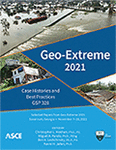Development of a Decision Support Framework for Multi-Hazard Resilience Assessment of Coastal Structures
Publication: Geo-Extreme 2021
ABSTRACT
Current methods for flood risk assessment do not incorporate the concept of flood damage, structural resiliency, and community vulnerability into a single holistic framework. Within this study, a robust flood risk assessment framework has been developed which includes hydrodynamic characteristic of flooding coupled with the concept of flood damage, resiliency, and vulnerability through various modeling and geospatial analytics. First a state-of-the-art, high-resolution two-dimensional (2D) hydrodynamic model was developed to analyze the impact of storm surge into the coastal communities. Next, a new flood damage model was proposed which includes the dynamic characteristics of flooding as well as various relevant characteristics of a building including age, materials, height, and location. A resiliency model was also developed incorporating the flood induced damage level with the recovery factor of the structures at micro- and mesoscale. Finally, the vulnerability of a community due to extreme storm events was quantified by including damage and the resiliency of the community at mesoscale.
Get full access to this article
View all available purchase options and get full access to this chapter.
REFERENCES
1. Arikawa, T., Seki, K., Chida, Y., Takagawa, T., and Shimosako, K. (2018). Development of Multiscale Multiphysics Integrated Simulator for Tsunami Runup Calculation Coupled with Structure Analysis. Coastal Engineering Proceedings, 1(36), 60.
2. Blake, E. S., Kimberlain, T. B., Berg, R. J., Cangialosi, J. P., and Beven, J. L. (2013). Tropical cyclone report: Hurricane sandy. National Hurricane Center, 12, 1–10.
3. Botts, H., Du, W., Jeffery, T., Kolk, S., Pennycook, Z., and Suhr, L. (2013). CoreLogic storm surge report.
4. Bruneau, M., Chang, S. E., Eguchi, R. T., Lee, G. C., O’Rourke, T. D., Reinhorn, A. M., and Von Winterfeldt, D. (2003). A framework to quantitatively assess and enhance the seismic resilience of communities. Earthquake spectra, 19(4), 733–752.
5. Cimellaro, G. P., Reinhorn, A. M., and Bruneau, M. (2010). Framework for analytical quantification of disaster resilience. Engineering structures, 32(11), 3639–3649.
6. de Koning, K., Filatova, T., Need, A., and Bin, O. (2019). Avoiding or mitigating flooding: Bottom-up drivers of urban resilience to climate change in the USA. Global environmental change, 59, 101981.
7. Dominey-Howes, D., and Papathoma, M. (2007). Validating a tsunami vulnerability assessment model (the PTVA model) using field data from the 2004 Indian Ocean tsunami. Natural Hazards, 40(1), 113–136.
8. Fahad, G. R., Nazari, R., Daraio, J., and Lundberg, D. J. (2017). Regional Study of Future Temperature and Precipitation Changes Using Bias Corrected Multi-Model Ensemble Projections Considering High Emission Pathways. J Earth Sci Clim Change, 8(409), 2.
9. Fahad, M. G. R., Nazari, R., Bhavsar, P., Jalayer, M., and Karimi, M. (2019). A decision-support framework for emergency evacuation planning during extreme storm events. Transportation research part D: transport and environment, 77, 589–605.
10. Fahad, M. G. R., Nazari, R., Motamedi, M. H., and Karimi, M. E.et al. (2020). Coupled Hydrodynamic and Geospatial Model for Assessing Resiliency of Coastal Structures under Extreme Storm Scenarios. Water Resour Manage 34, 1123–1138. https://doi.org/10.1007/s11269-020-02490-y.
11. Fahad, M. G. R., Saiful Islam, A. K. M., Nazari, R., Alfi Hasan, M., Tarekul Islam, G. M., and Bala, S. K. (2018). Regional changes of precipitation and temperature over Bangladesh using bias‐corrected multi‐model ensemble projections considering high‐emission pathways. International Journal of Climatology, 38(4), 1634–1648.
12. Lukkunaprasit, P., Ruangrassamee, A., Stitmannaithum, B., Chintanapakdee, C., and Thanasisathit, N. (2010). Calibration of tsunami loading on a damaged building. Journal of Earthquake and Tsunami, 4(02), 105–114.
13. Matsutomi, H., Okamoto, K., and Harada, K. (2011). Inundation flow velocity of tsunami on land and its practical use. Coastal Engineering, 32.
14. MOTF, FEMA. (2014). FEMA Modeling Task Force (MOTF)-Hurricane Sandy Impact Analysis. FEMA MOTF.
15. Pistrika, A. K., and Jonkman, S. N. (2010). Damage to residential buildings due to flooding of New Orleans after hurricane Katrina. Natural Hazards, 54(2), 413–434.
16. Ruangrassamee, A., Yanagisawa, H., Foytong, P., Lukkunaprasit, P., Koshimura, S., and Imamura, F. (2006). Investigation of tsunami-induced damage and fragility of buildings in Thailand after the December 2004 Indian Ocean tsunami. Earthquake Spectra, 22(3_suppl), 377–401.
17. Sabrin, S., Karimi, M., Fahad, M. G. R., and Nazari, R. (2020). Quantifying environmental and social vulnerability: Role of urban Heat Island and air quality, a case study of Camden, NJ. Urban Climate, 34, 100699.
18. Stelling, G. S. (1983). On the construction of computational methods for shallow water flow problems.
19. Uddin, M. N., Islam, A. S., Bala, S. K., Islam, G. T., Adhikary, S., Saha, D., and Akter, R. (2019). Mapping of climate vulnerability of the coastal region of Bangladesh using principal component analysis. Applied geography, 102, 47–57.
20. WBM, B. (2008). Tuflow user manual-gis based 2d/1d hydrodynamic modelling.
21. Cialone, M. A., Grzegorzewski, A. S., Mark, D. J., Bryant, M. A., and Massey, T. C. (2017). Coastal-storm model development and water-level validation for the North Atlantic Coast Comprehensive Study. Journal of Waterway, Port, Coastal, and Ocean Engineering, 143(5), 04017031.
22. Bacopoulos, P., and Hagen, S. C. (2017). The intertidal zones of the South Atlantic Bight and their local and regional influence on astronomical tides. Ocean Modelling, 119, 13–34.
Information & Authors
Information
Published In
Copyright
© 2021 American Society of Civil Engineers.
History
Published online: Nov 4, 2021
Authors
Metrics & Citations
Metrics
Citations
Download citation
If you have the appropriate software installed, you can download article citation data to the citation manager of your choice. Simply select your manager software from the list below and click Download.
